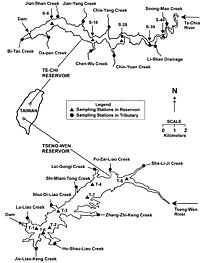Monitoring:Eutrophication
Modeling Application: Eutrophication
Objective
The objective of this[1] study was to quantify the mass transport, thermal stratification, and water quality variations in the Te-Chi Reservoir (in the temperate climates) and the Tseng-Wen Reservoir (in the sub-tropical climates) in Taiwan using CE-QUAL-W2. More specifically, the model results were used to quantify the cause-and-effect relationship between nutrient loads and water quality in these two reservoirs.
Data Needs
- Initial Conditions
- The initial conditions that were used in the model are not specified in the report.
- Boundary Conditions
- Time variable main inflow
- Inflow Temperatures
- Water Quality: Dissolved oxygen, chlorophyll a, total phosphorous, ammonia, and nitrite/nitrate concentrations at the upstream ends of the main stem of the river. Additionally, concentrations of dissolved oxygen, chlorophyll a, and nutrients in the tributaries were incorporated.
- Meteorological Data: Includes air temperature, dew point temperature, wind speed, wind direction, and cloud cover
Monitoring Needs
- In-Pool/In-Situ Data
- Water temperature profiles
- Dissolved oxygen profiles
- Water Budget
- Time-variable water surface elevation data
Te-Chi Reservoir: The water quality of Te-Chi reservoir has been routinely monitored during the past three decades, at a frequency of once a season since 1998. There are 15 water-quality sampling stations in the reservoir and its tributaries. Monitoring includes:
- Water temperature
- Dissolved oxygen
- Chlorophyll a
- Nutrients
- Total phosphorous
- Ammonia-nitrogen
- Nitrite/Nitrate nitrogen
Tseng-Wen Reservoir: There are 16 water quality sampling stations within the reservoir and its nine tributaries. The water quality sampling monitoring has been conducted once a month since 1999. Water quality monitoring consists of the same parameters as is indicated for Te-Chi Reservoir.
